engine CADILLAC SRX 2008 1.G User Guide
[x] Cancel search | Manufacturer: CADILLAC, Model Year: 2008, Model line: SRX, Model: CADILLAC SRX 2008 1.GPages: 448, PDF Size: 5.61 MB
Page 106 of 448
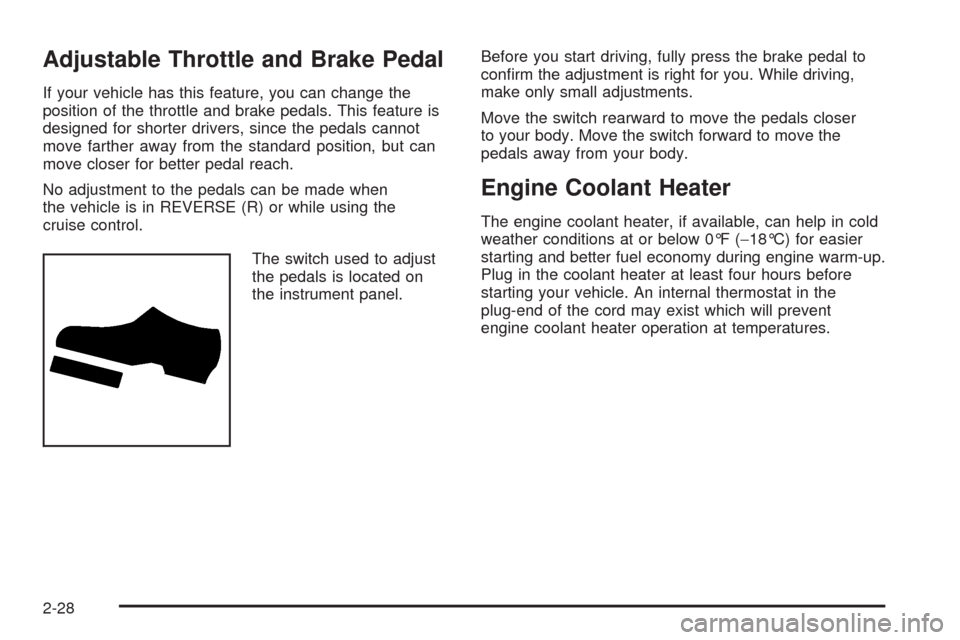
Adjustable Throttle and Brake Pedal
If your vehicle has this feature, you can change the
position of the throttle and brake pedals. This feature is
designed for shorter drivers, since the pedals cannot
move farther away from the standard position, but can
move closer for better pedal reach.
No adjustment to the pedals can be made when
the vehicle is in REVERSE (R) or while using the
cruise control.
The switch used to adjust
the pedals is located on
the instrument panel.Before you start driving, fully press the brake pedal to
con�rm the adjustment is right for you. While driving,
make only small adjustments.
Move the switch rearward to move the pedals closer
to your body. Move the switch forward to move the
pedals away from your body.
Engine Coolant Heater
The engine coolant heater, if available, can help in cold
weather conditions at or below 0°F (−18°C) for easier
starting and better fuel economy during engine warm-up.
Plug in the coolant heater at least four hours before
starting your vehicle. An internal thermostat in the
plug-end of the cord may exist which will prevent
engine coolant heater operation at temperatures.
2-28
Page 107 of 448
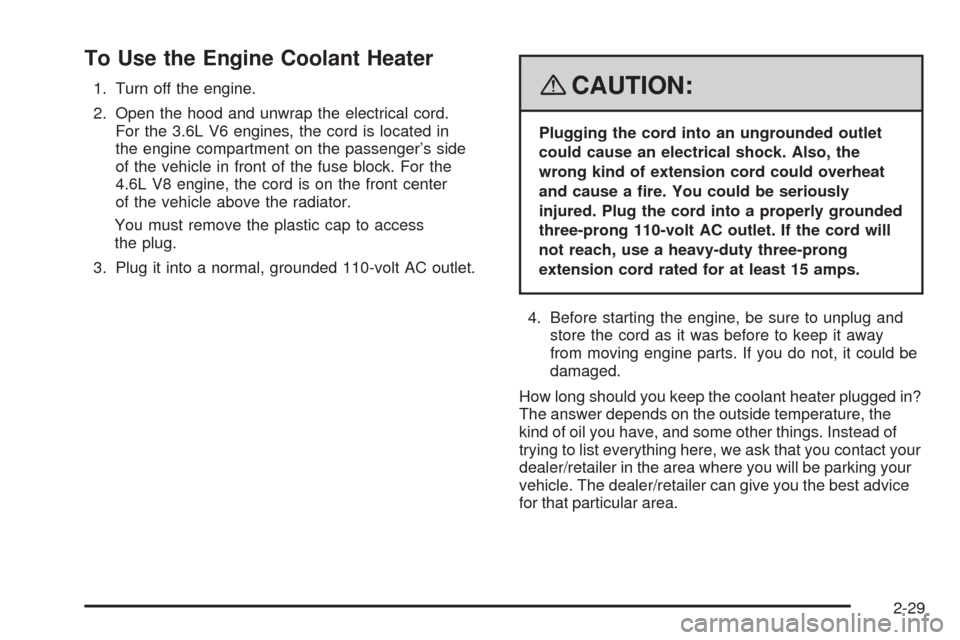
To Use the Engine Coolant Heater
1. Turn off the engine.
2. Open the hood and unwrap the electrical cord.
For the 3.6L V6 engines, the cord is located in
the engine compartment on the passenger’s side
of the vehicle in front of the fuse block. For the
4.6L V8 engine, the cord is on the front center
of the vehicle above the radiator.
You must remove the plastic cap to access
the plug.
3. Plug it into a normal, grounded 110-volt AC outlet.{CAUTION:
Plugging the cord into an ungrounded outlet
could cause an electrical shock. Also, the
wrong kind of extension cord could overheat
and cause a �re. You could be seriously
injured. Plug the cord into a properly grounded
three-prong 110-volt AC outlet. If the cord will
not reach, use a heavy-duty three-prong
extension cord rated for at least 15 amps.
4. Before starting the engine, be sure to unplug and
store the cord as it was before to keep it away
from moving engine parts. If you do not, it could be
damaged.
How long should you keep the coolant heater plugged in?
The answer depends on the outside temperature, the
kind of oil you have, and some other things. Instead of
trying to list everything here, we ask that you contact your
dealer/retailer in the area where you will be parking your
vehicle. The dealer/retailer can give you the best advice
for that particular area.
2-29
Page 108 of 448
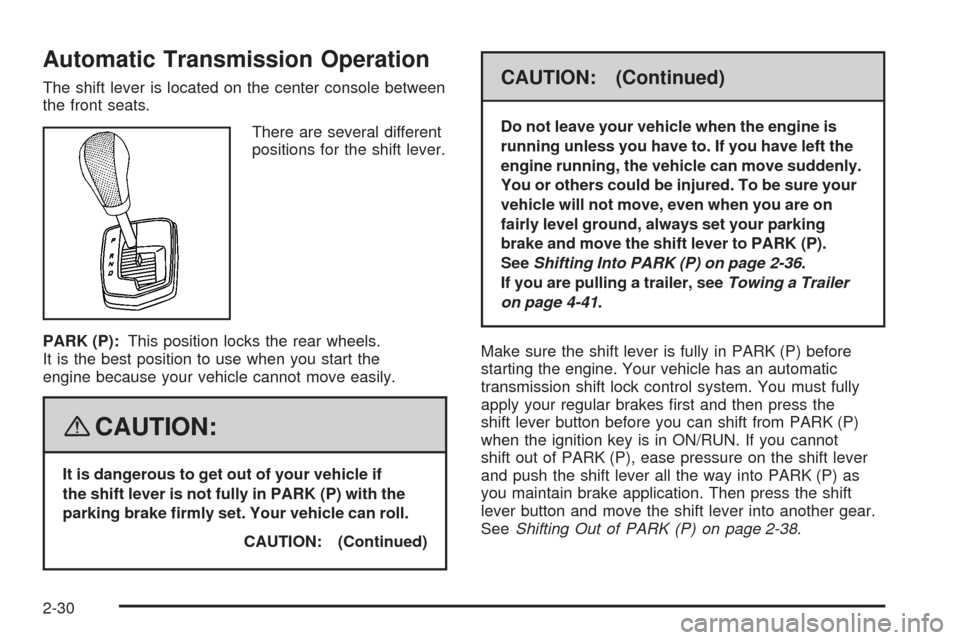
Automatic Transmission Operation
The shift lever is located on the center console between
the front seats.
There are several different
positions for the shift lever.
PARK (P):This position locks the rear wheels.
It is the best position to use when you start the
engine because your vehicle cannot move easily.
{CAUTION:
It is dangerous to get out of your vehicle if
the shift lever is not fully in PARK (P) with the
parking brake �rmly set. Your vehicle can roll.
CAUTION: (Continued)
CAUTION: (Continued)
Do not leave your vehicle when the engine is
running unless you have to. If you have left the
engine running, the vehicle can move suddenly.
You or others could be injured. To be sure your
vehicle will not move, even when you are on
fairly level ground, always set your parking
brake and move the shift lever to PARK (P).
SeeShifting Into PARK (P) on page 2-36.
If you are pulling a trailer, seeTowing a Trailer
on page 4-41.
Make sure the shift lever is fully in PARK (P) before
starting the engine. Your vehicle has an automatic
transmission shift lock control system. You must fully
apply your regular brakes �rst and then press the
shift lever button before you can shift from PARK (P)
when the ignition key is in ON/RUN. If you cannot
shift out of PARK (P), ease pressure on the shift lever
and push the shift lever all the way into PARK (P) as
you maintain brake application. Then press the shift
lever button and move the shift lever into another gear.
SeeShifting Out of PARK (P) on page 2-38.
2-30
Page 109 of 448
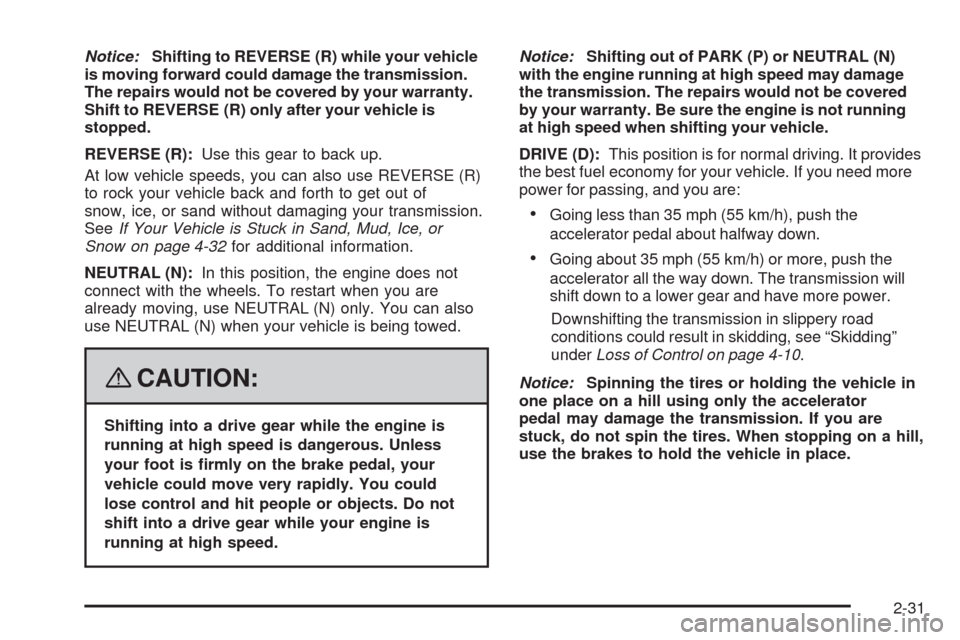
Notice:Shifting to REVERSE (R) while your vehicle
is moving forward could damage the transmission.
The repairs would not be covered by your warranty.
Shift to REVERSE (R) only after your vehicle is
stopped.
REVERSE (R):Use this gear to back up.
At low vehicle speeds, you can also use REVERSE (R)
to rock your vehicle back and forth to get out of
snow, ice, or sand without damaging your transmission.
SeeIf Your Vehicle is Stuck in Sand, Mud, Ice, or
Snow on page 4-32for additional information.
NEUTRAL (N):In this position, the engine does not
connect with the wheels. To restart when you are
already moving, use NEUTRAL (N) only. You can also
use NEUTRAL (N) when your vehicle is being towed.
{CAUTION:
Shifting into a drive gear while the engine is
running at high speed is dangerous. Unless
your foot is �rmly on the brake pedal, your
vehicle could move very rapidly. You could
lose control and hit people or objects. Do not
shift into a drive gear while your engine is
running at high speed.Notice:Shifting out of PARK (P) or NEUTRAL (N)
with the engine running at high speed may damage
the transmission. The repairs would not be covered
by your warranty. Be sure the engine is not running
at high speed when shifting your vehicle.
DRIVE (D):This position is for normal driving. It provides
the best fuel economy for your vehicle. If you need more
power for passing, and you are:
Going less than 35 mph (55 km/h), push the
accelerator pedal about halfway down.
Going about 35 mph (55 km/h) or more, push the
accelerator all the way down. The transmission will
shift down to a lower gear and have more power.
Downshifting the transmission in slippery road
conditions could result in skidding, see “Skidding”
underLoss of Control on page 4-10.
Notice:Spinning the tires or holding the vehicle in
one place on a hill using only the accelerator
pedal may damage the transmission. If you are
stuck, do not spin the tires. When stopping on a hill,
use the brakes to hold the vehicle in place.
2-31
Page 110 of 448
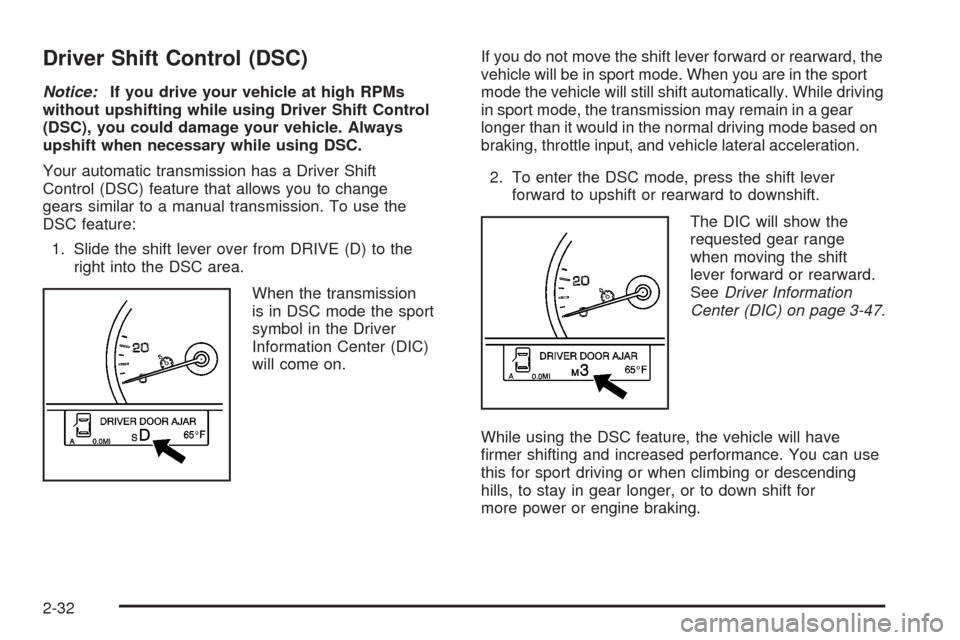
Driver Shift Control (DSC)
Notice:If you drive your vehicle at high RPMs
without upshifting while using Driver Shift Control
(DSC), you could damage your vehicle. Always
upshift when necessary while using DSC.
Your automatic transmission has a Driver Shift
Control (DSC) feature that allows you to change
gears similar to a manual transmission. To use the
DSC feature:
1. Slide the shift lever over from DRIVE (D) to the
right into the DSC area.
When the transmission
is in DSC mode the sport
symbol in the Driver
Information Center (DIC)
will come on.If you do not move the shift lever forward or rearward, the
vehicle will be in sport mode. When you are in the sport
mode the vehicle will still shift automatically. While driving
in sport mode, the transmission may remain in a gear
longer than it would in the normal driving mode based on
braking, throttle input, and vehicle lateral acceleration.
2. To enter the DSC mode, press the shift lever
forward to upshift or rearward to downshift.
The DIC will show the
requested gear range
when moving the shift
lever forward or rearward.
SeeDriver Information
Center (DIC) on page 3-47.
While using the DSC feature, the vehicle will have
�rmer shifting and increased performance. You can use
this for sport driving or when climbing or descending
hills, to stay in gear longer, or to down shift for
more power or engine braking.
2-32
Page 111 of 448
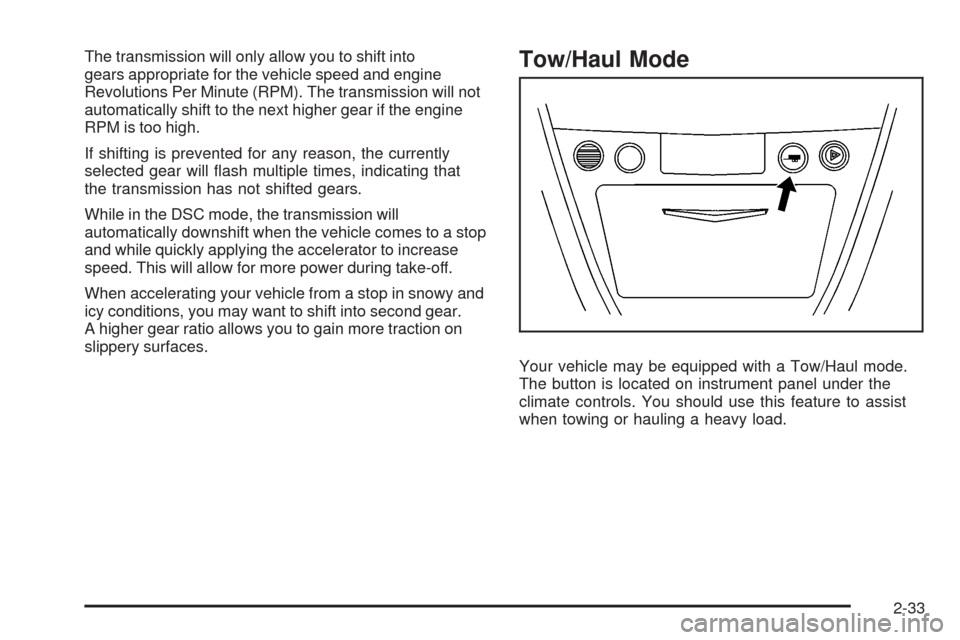
The transmission will only allow you to shift into
gears appropriate for the vehicle speed and engine
Revolutions Per Minute (RPM). The transmission will not
automatically shift to the next higher gear if the engine
RPM is too high.
If shifting is prevented for any reason, the currently
selected gear will �ash multiple times, indicating that
the transmission has not shifted gears.
While in the DSC mode, the transmission will
automatically downshift when the vehicle comes to a stop
and while quickly applying the accelerator to increase
speed. This will allow for more power during take-off.
When accelerating your vehicle from a stop in snowy and
icy conditions, you may want to shift into second gear.
A higher gear ratio allows you to gain more traction on
slippery surfaces.Tow/Haul Mode
Your vehicle may be equipped with a Tow/Haul mode.
The button is located on instrument panel under the
climate controls. You should use this feature to assist
when towing or hauling a heavy load.
2-33
Page 112 of 448
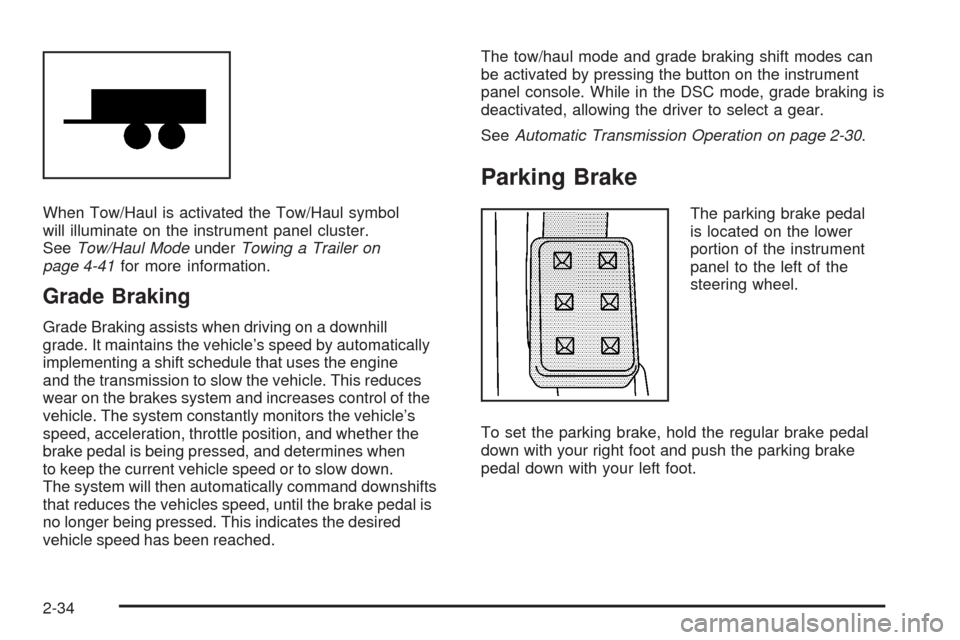
When Tow/Haul is activated the Tow/Haul symbol
will illuminate on the instrument panel cluster.
SeeTow/Haul ModeunderTowing a Trailer on
page 4-41for more information.
Grade Braking
Grade Braking assists when driving on a downhill
grade. It maintains the vehicle’s speed by automatically
implementing a shift schedule that uses the engine
and the transmission to slow the vehicle. This reduces
wear on the brakes system and increases control of the
vehicle. The system constantly monitors the vehicle’s
speed, acceleration, throttle position, and whether the
brake pedal is being pressed, and determines when
to keep the current vehicle speed or to slow down.
The system will then automatically command downshifts
that reduces the vehicles speed, until the brake pedal is
no longer being pressed. This indicates the desired
vehicle speed has been reached.The tow/haul mode and grade braking shift modes can
be activated by pressing the button on the instrument
panel console. While in the DSC mode, grade braking is
deactivated, allowing the driver to select a gear.
SeeAutomatic Transmission Operation on page 2-30.
Parking Brake
The parking brake pedal
is located on the lower
portion of the instrument
panel to the left of the
steering wheel.
To set the parking brake, hold the regular brake pedal
down with your right foot and push the parking brake
pedal down with your left foot.
2-34
Page 114 of 448
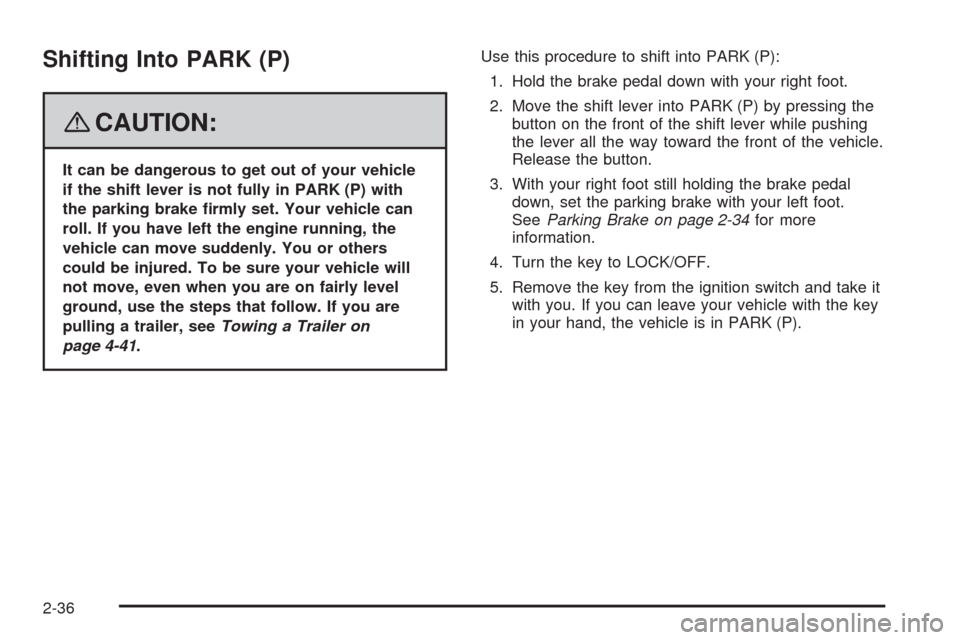
Shifting Into PARK (P)
{CAUTION:
It can be dangerous to get out of your vehicle
if the shift lever is not fully in PARK (P) with
the parking brake �rmly set. Your vehicle can
roll. If you have left the engine running, the
vehicle can move suddenly. You or others
could be injured. To be sure your vehicle will
not move, even when you are on fairly level
ground, use the steps that follow. If you are
pulling a trailer, seeTowing a Trailer on
page 4-41.Use this procedure to shift into PARK (P):
1. Hold the brake pedal down with your right foot.
2. Move the shift lever into PARK (P) by pressing the
button on the front of the shift lever while pushing
the lever all the way toward the front of the vehicle.
Release the button.
3. With your right foot still holding the brake pedal
down, set the parking brake with your left foot.
SeeParking Brake on page 2-34for more
information.
4. Turn the key to LOCK/OFF.
5. Remove the key from the ignition switch and take it
with you. If you can leave your vehicle with the key
in your hand, the vehicle is in PARK (P).
2-36
Page 115 of 448
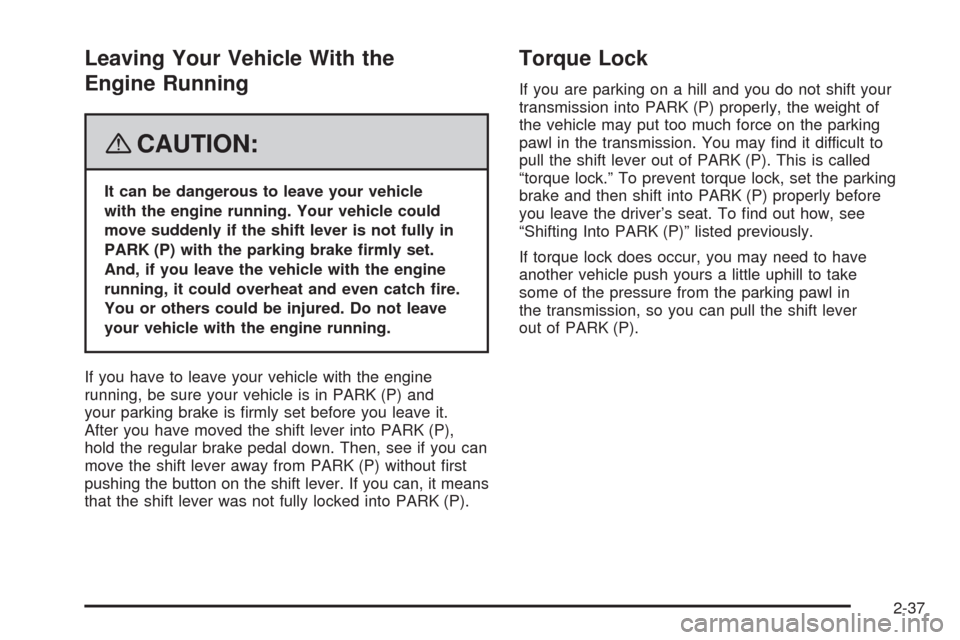
Leaving Your Vehicle With the
Engine Running
{CAUTION:
It can be dangerous to leave your vehicle
with the engine running. Your vehicle could
move suddenly if the shift lever is not fully in
PARK (P) with the parking brake �rmly set.
And, if you leave the vehicle with the engine
running, it could overheat and even catch �re.
You or others could be injured. Do not leave
your vehicle with the engine running.
If you have to leave your vehicle with the engine
running, be sure your vehicle is in PARK (P) and
your parking brake is �rmly set before you leave it.
After you have moved the shift lever into PARK (P),
hold the regular brake pedal down. Then, see if you can
move the shift lever away from PARK (P) without �rst
pushing the button on the shift lever. If you can, it means
that the shift lever was not fully locked into PARK (P).
Torque Lock
If you are parking on a hill and you do not shift your
transmission into PARK (P) properly, the weight of
the vehicle may put too much force on the parking
pawl in the transmission. You may �nd it difficult to
pull the shift lever out of PARK (P). This is called
“torque lock.” To prevent torque lock, set the parking
brake and then shift into PARK (P) properly before
you leave the driver’s seat. To �nd out how, see
“Shifting Into PARK (P)” listed previously.
If torque lock does occur, you may need to have
another vehicle push yours a little uphill to take
some of the pressure from the parking pawl in
the transmission, so you can pull the shift lever
out of PARK (P).
2-37
Page 117 of 448
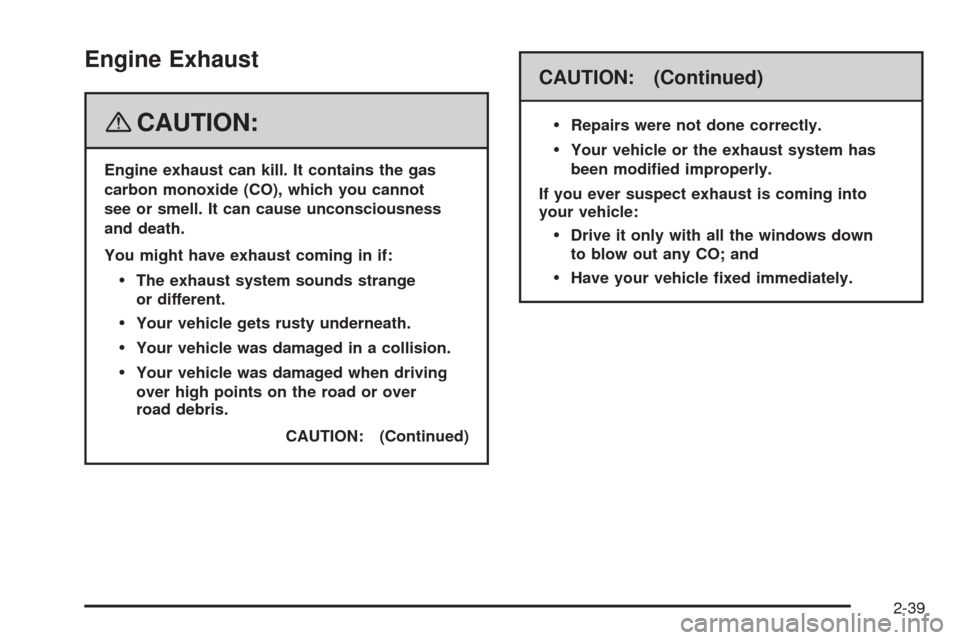
Engine Exhaust
{CAUTION:
Engine exhaust can kill. It contains the gas
carbon monoxide (CO), which you cannot
see or smell. It can cause unconsciousness
and death.
You might have exhaust coming in if:
The exhaust system sounds strange
or different.
Your vehicle gets rusty underneath.
Your vehicle was damaged in a collision.
Your vehicle was damaged when driving
over high points on the road or over
road debris.
CAUTION: (Continued)
CAUTION: (Continued)
Repairs were not done correctly.
Your vehicle or the exhaust system has
been modi�ed improperly.
If you ever suspect exhaust is coming into
your vehicle:
Drive it only with all the windows down
to blow out any CO; and
Have your vehicle �xed immediately.
2-39